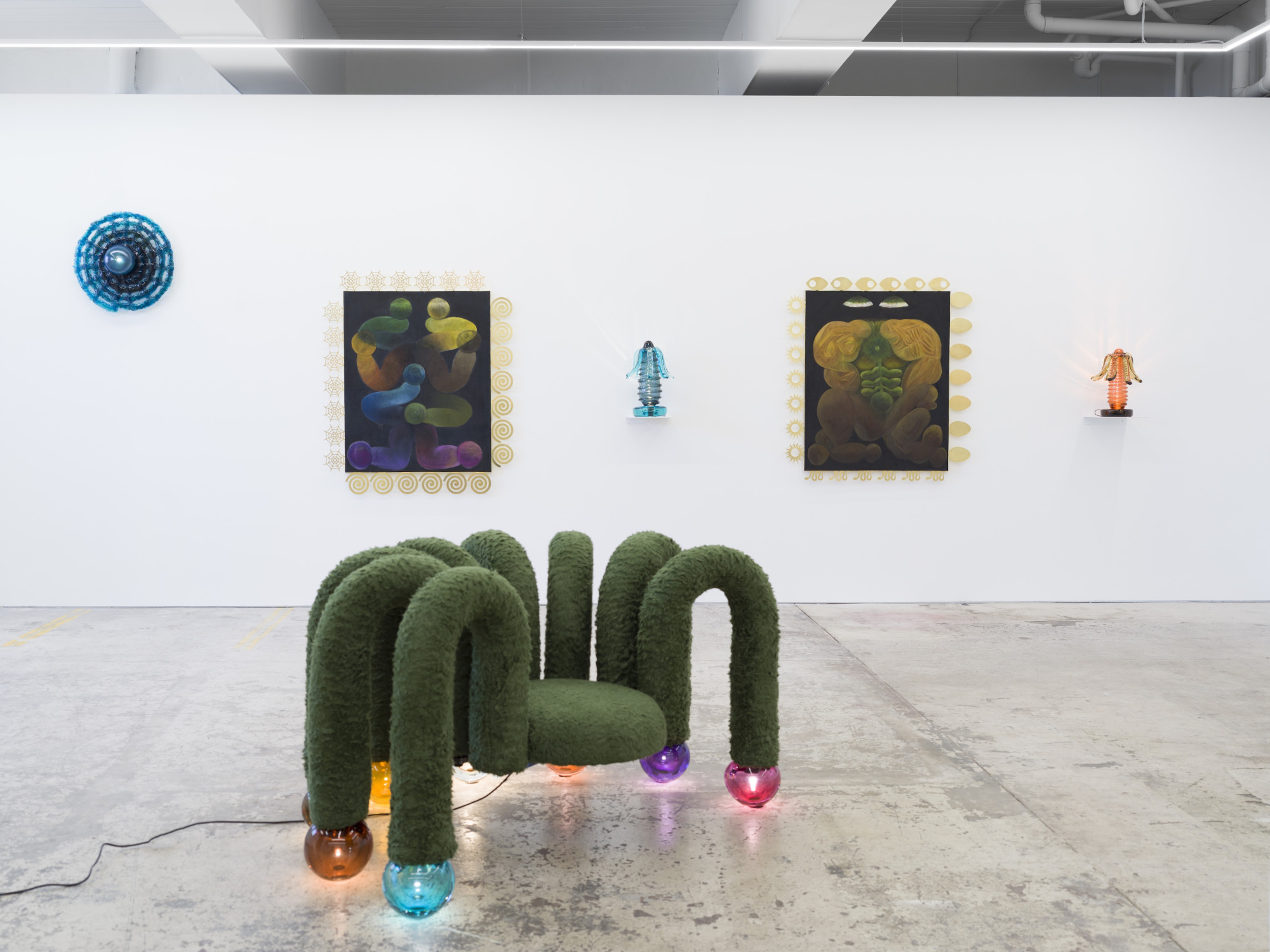
In her second solo exhibition at PALAS, Tamara Henderson presents Tantramar: The Eight Legs of Life, an evolving body of work first developed for Warrnambool Art Gallery.
Expanding her mythological lexicon, Henderson revisits the recurring figures of Sound Shepard and Sunspider, and unearths their alchemical counterpart, Wiseguide. Embodying the tantric dualities of movement and stillness, these cosmic companions drift through a terrain where sculpture, painting, and sound sway together in a hypnotic groove.
In dialogue with the unseen systems of life, rhythm, and transformation, Henderson evokes a dense, fertile murk — a sustaining ground that holds her narrative and nourishes the evolving ecosystem of sculpture, painting, and sound. This convergence of forms and figures points toward the quiet play of mystery and form that courses through her practice — and toward Mar, the sea that carried them all here.
- Julia Dunne
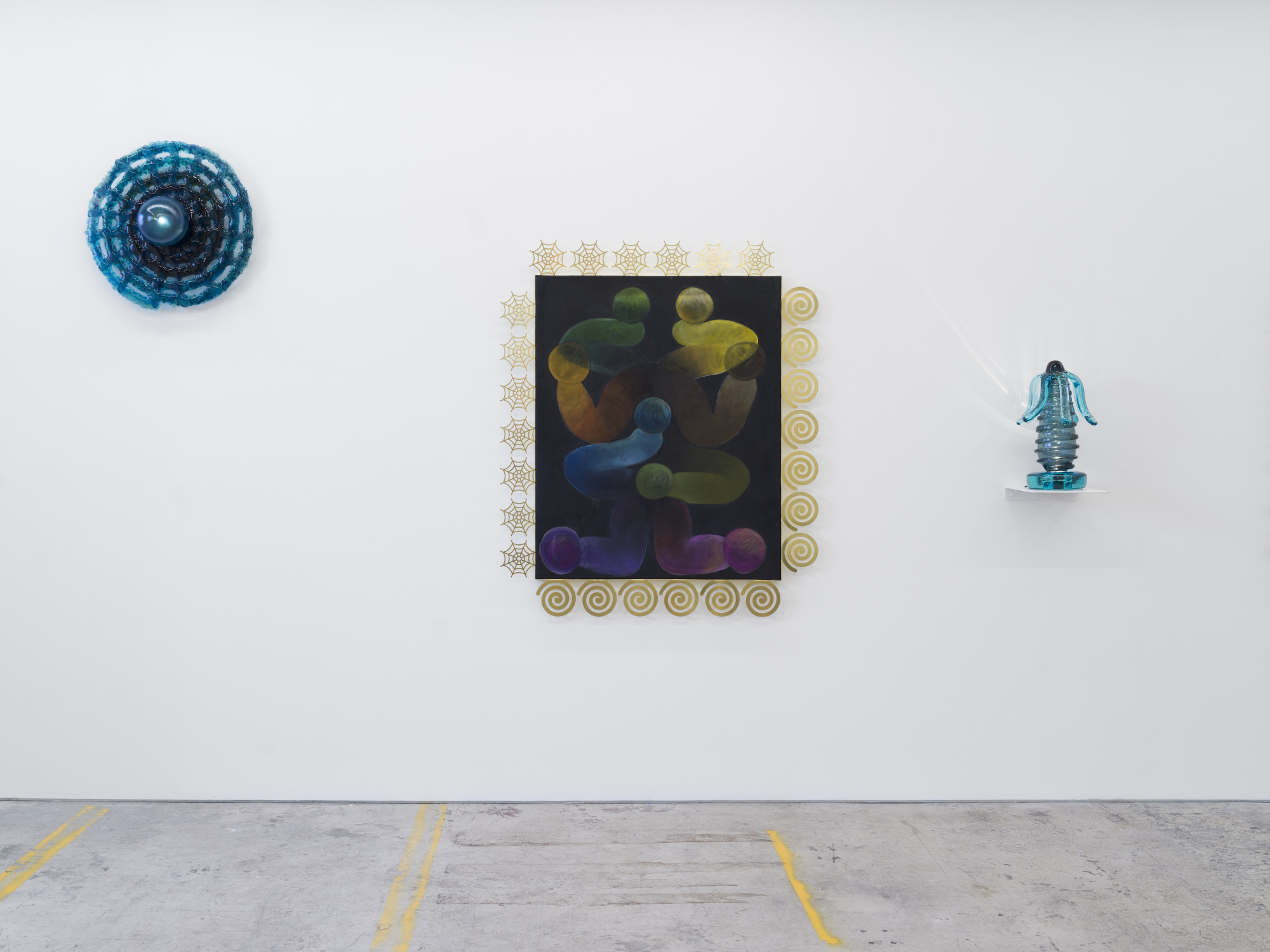

2025
Blown glass, light, electrical cabling
50 x 30 x 30 cm
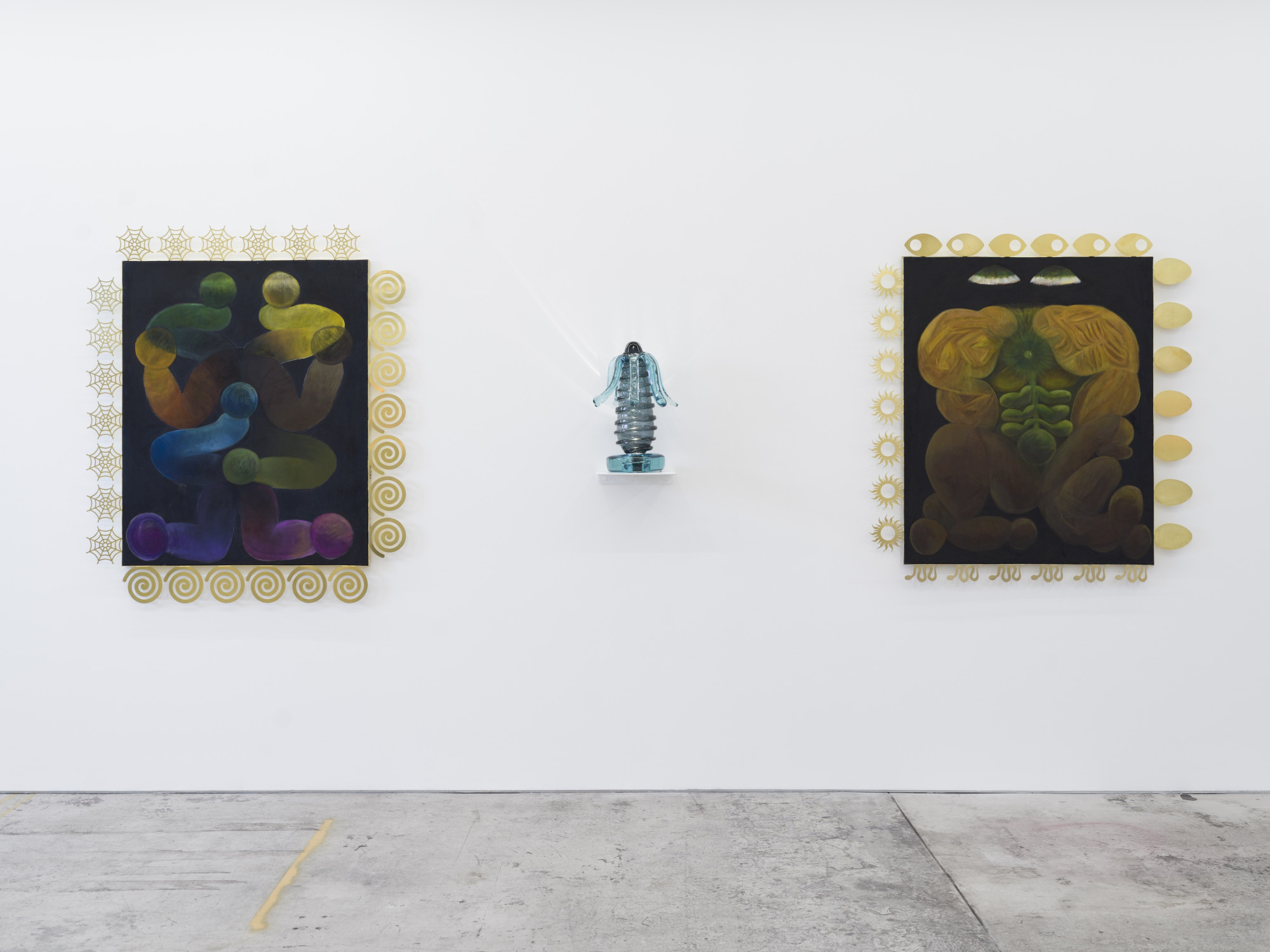

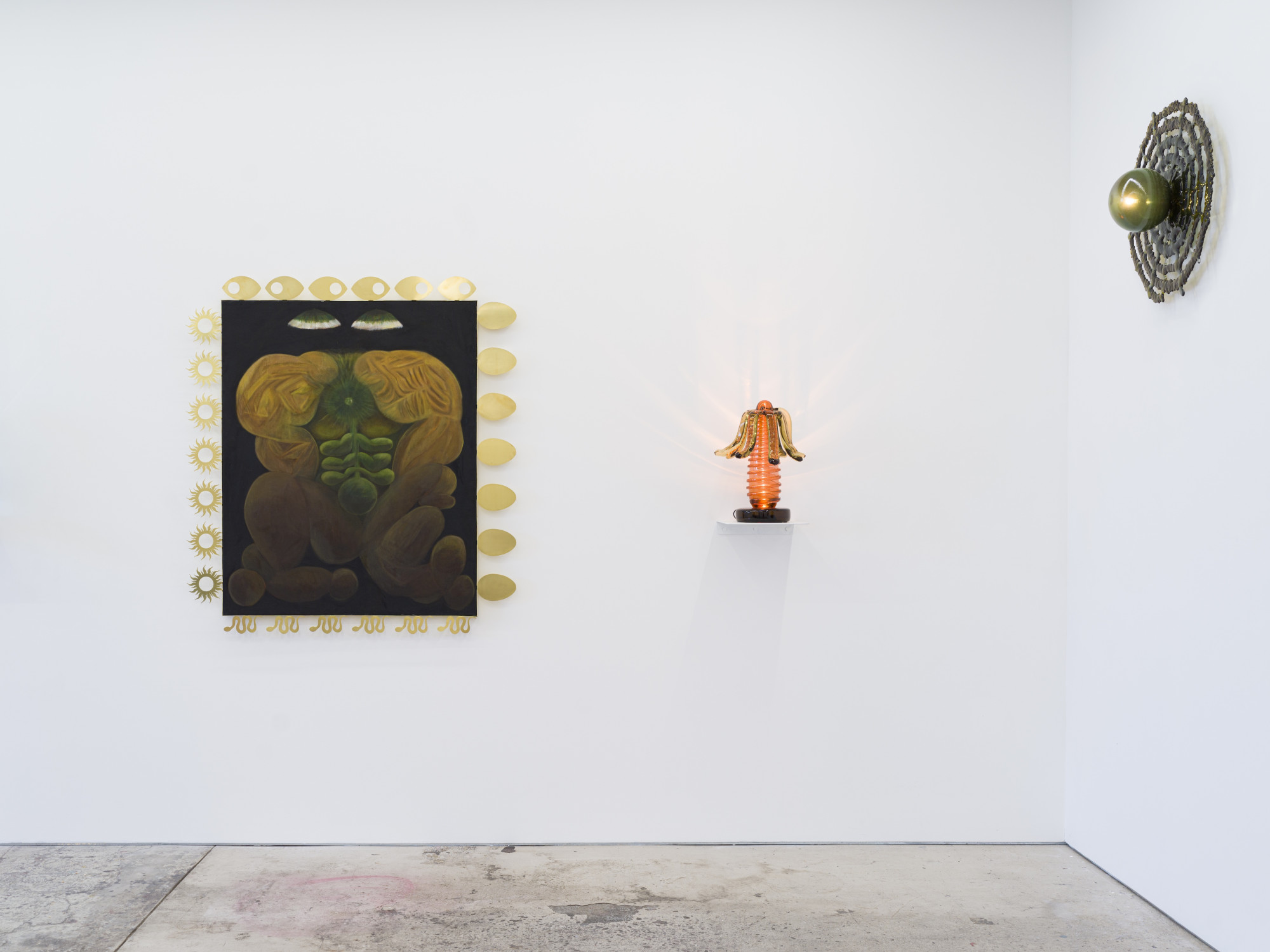

2025
Blown glass, light, electrical cabling
44 x 30 x 30 cm
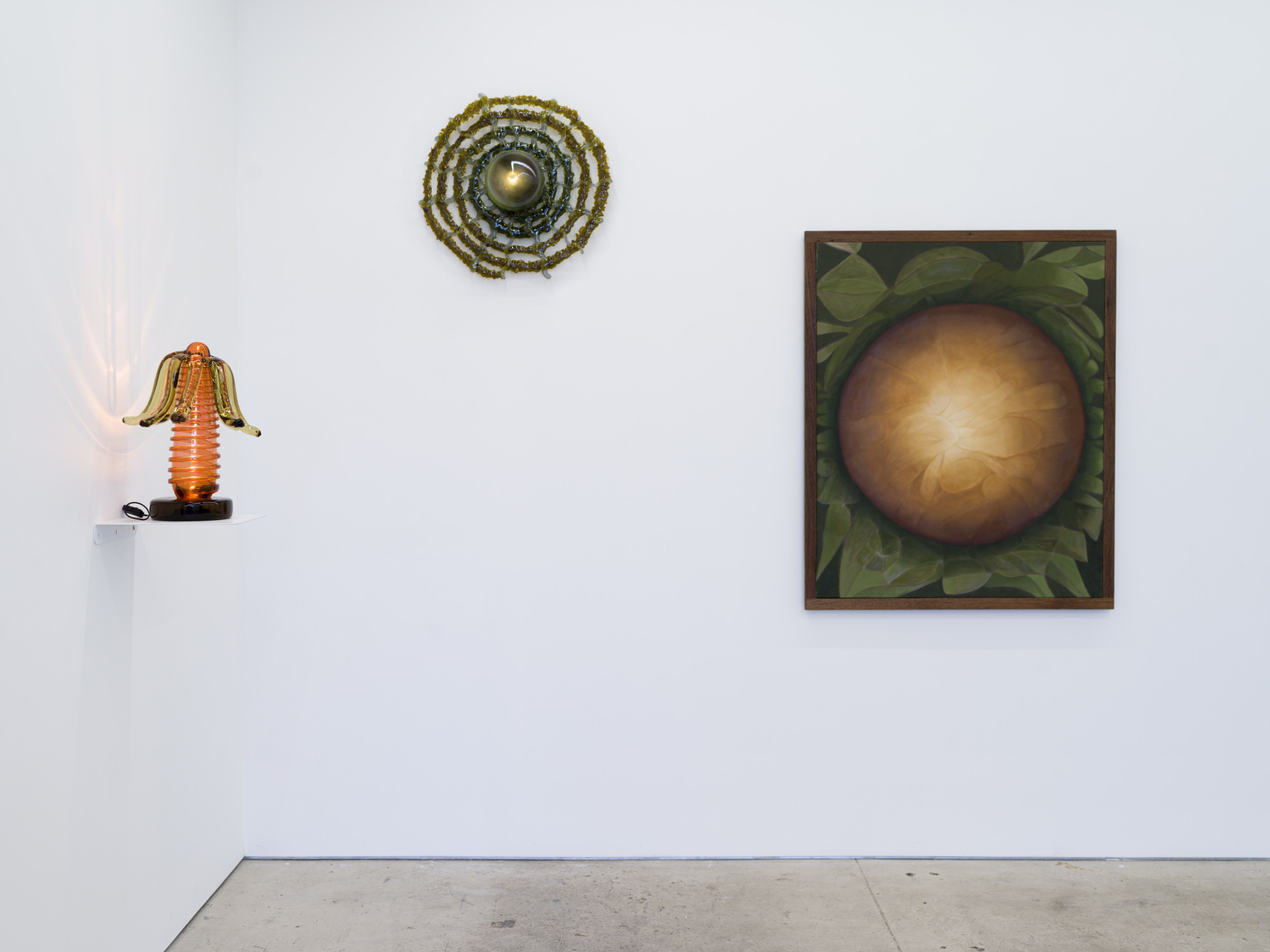
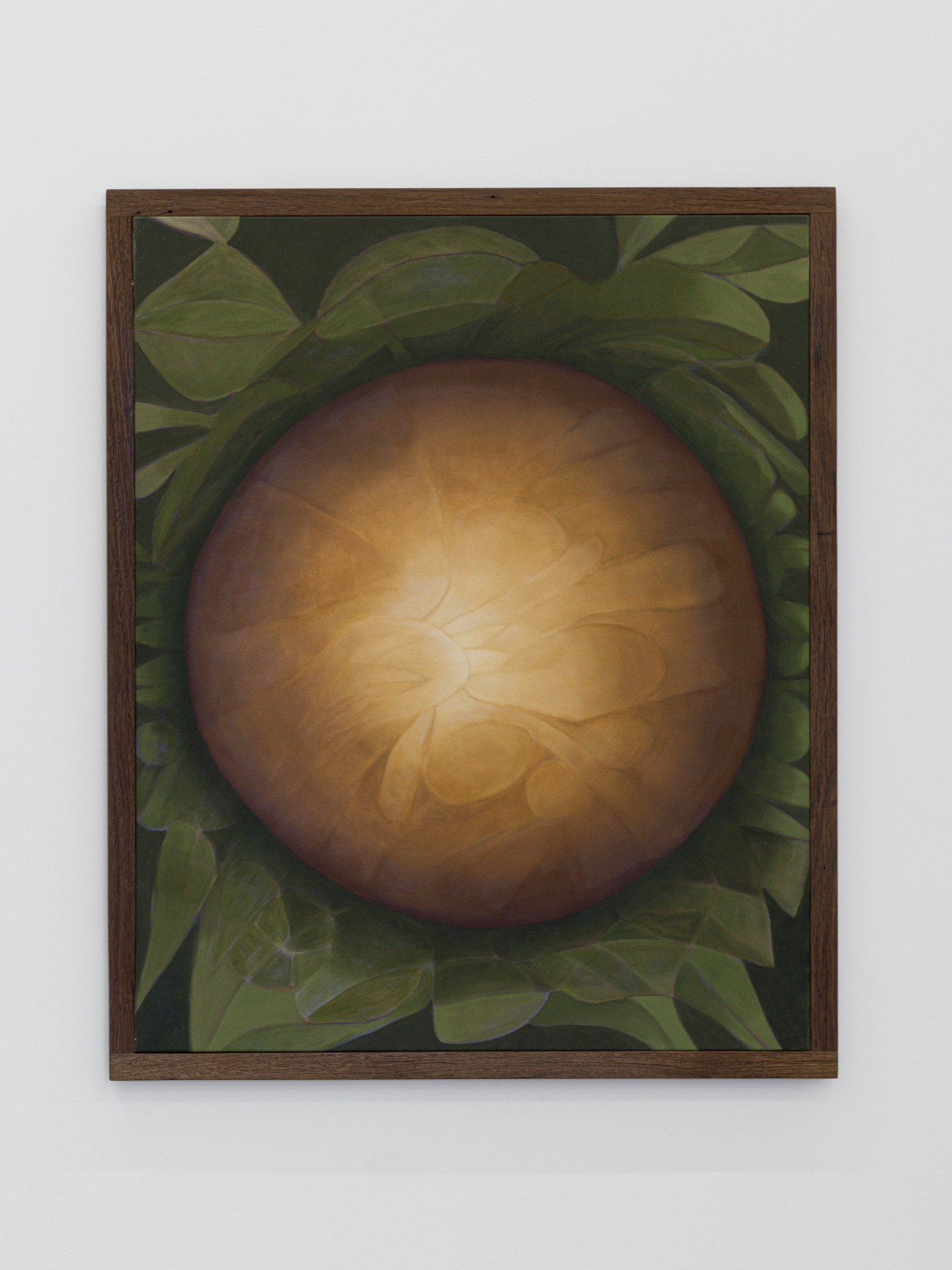
2025
Oil on canvas in artist frame
128 x 115 x 3 cm


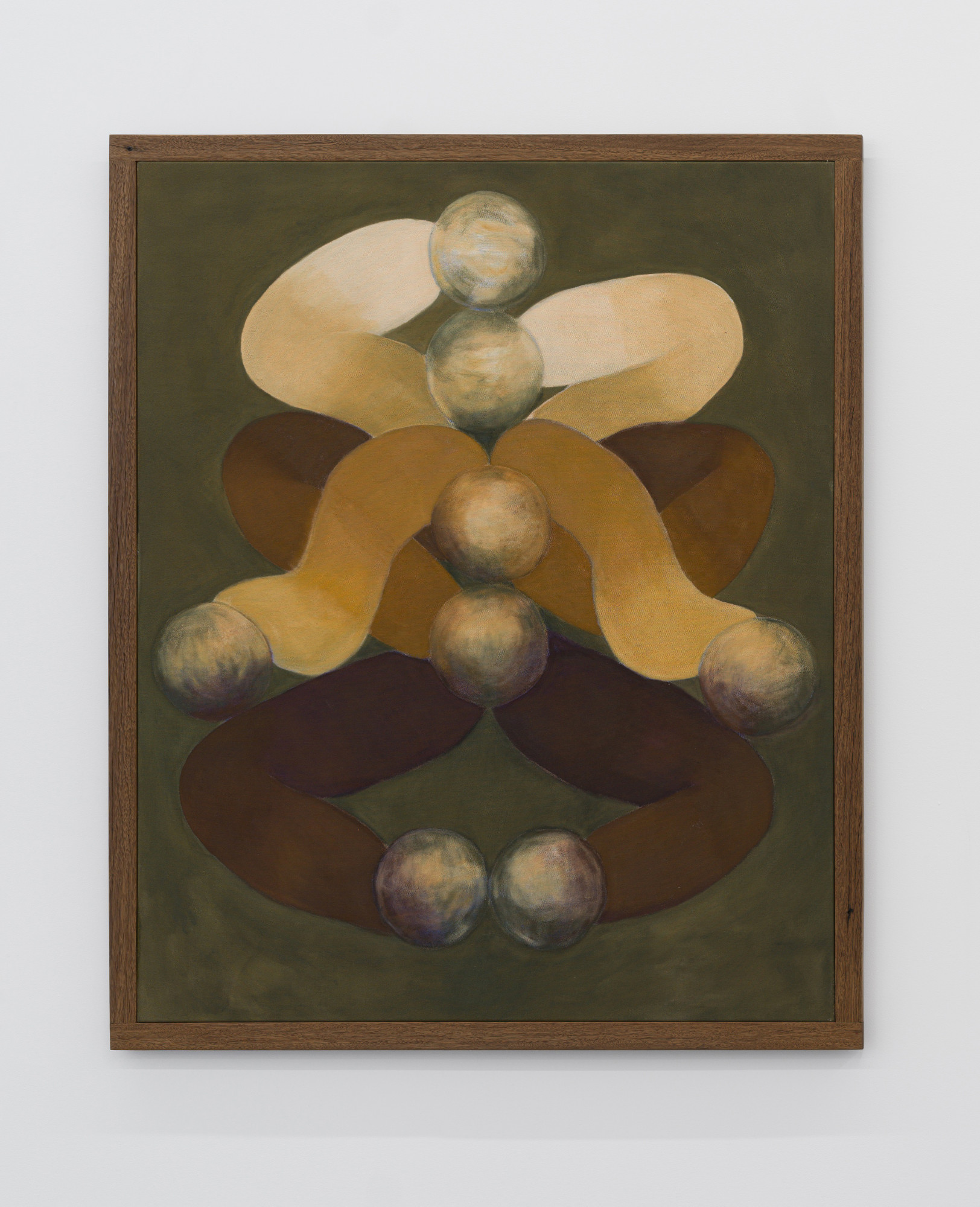
2025
Oil on canvas in artist frame
128 x 115 x 3.5 cm
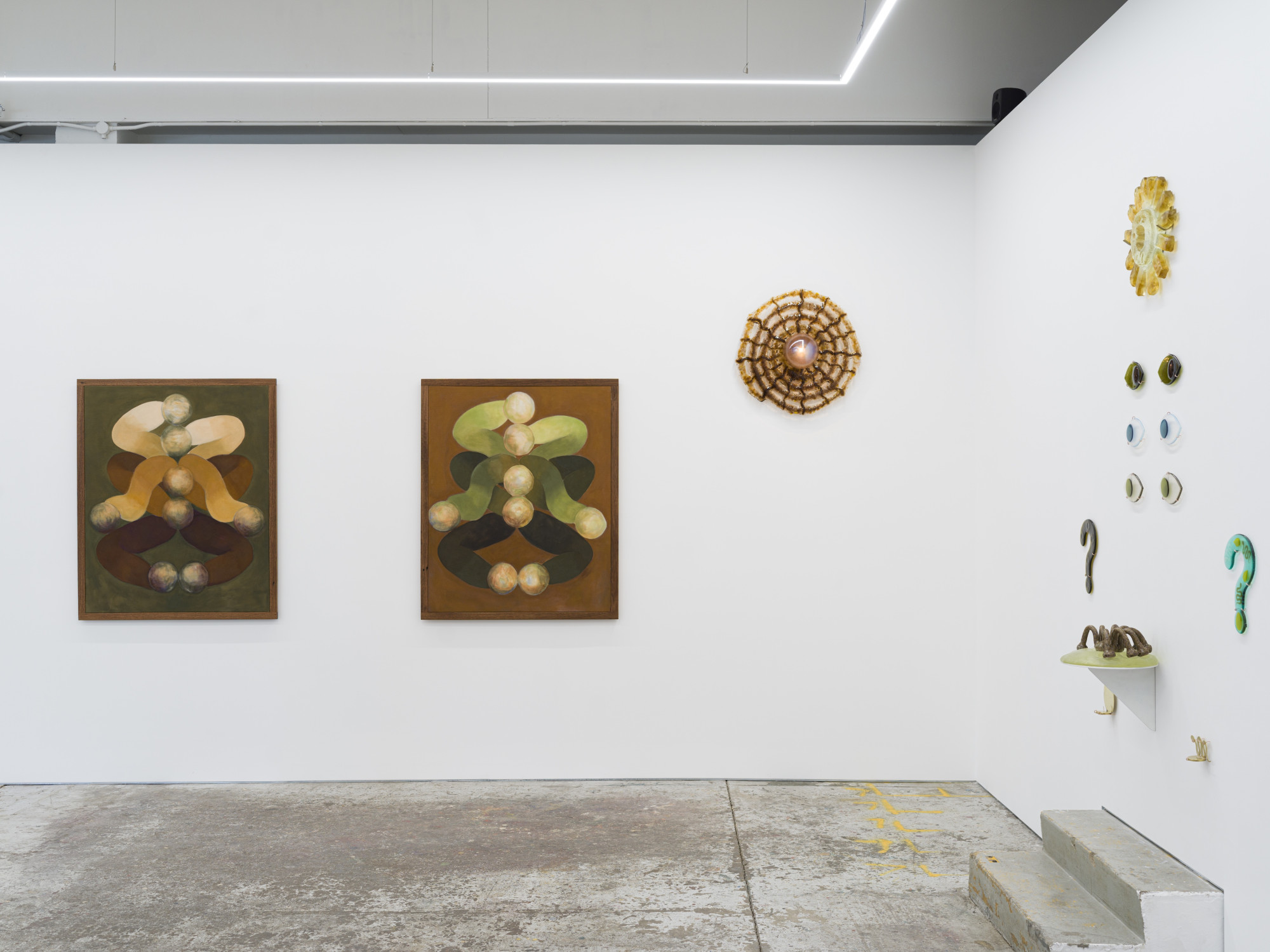
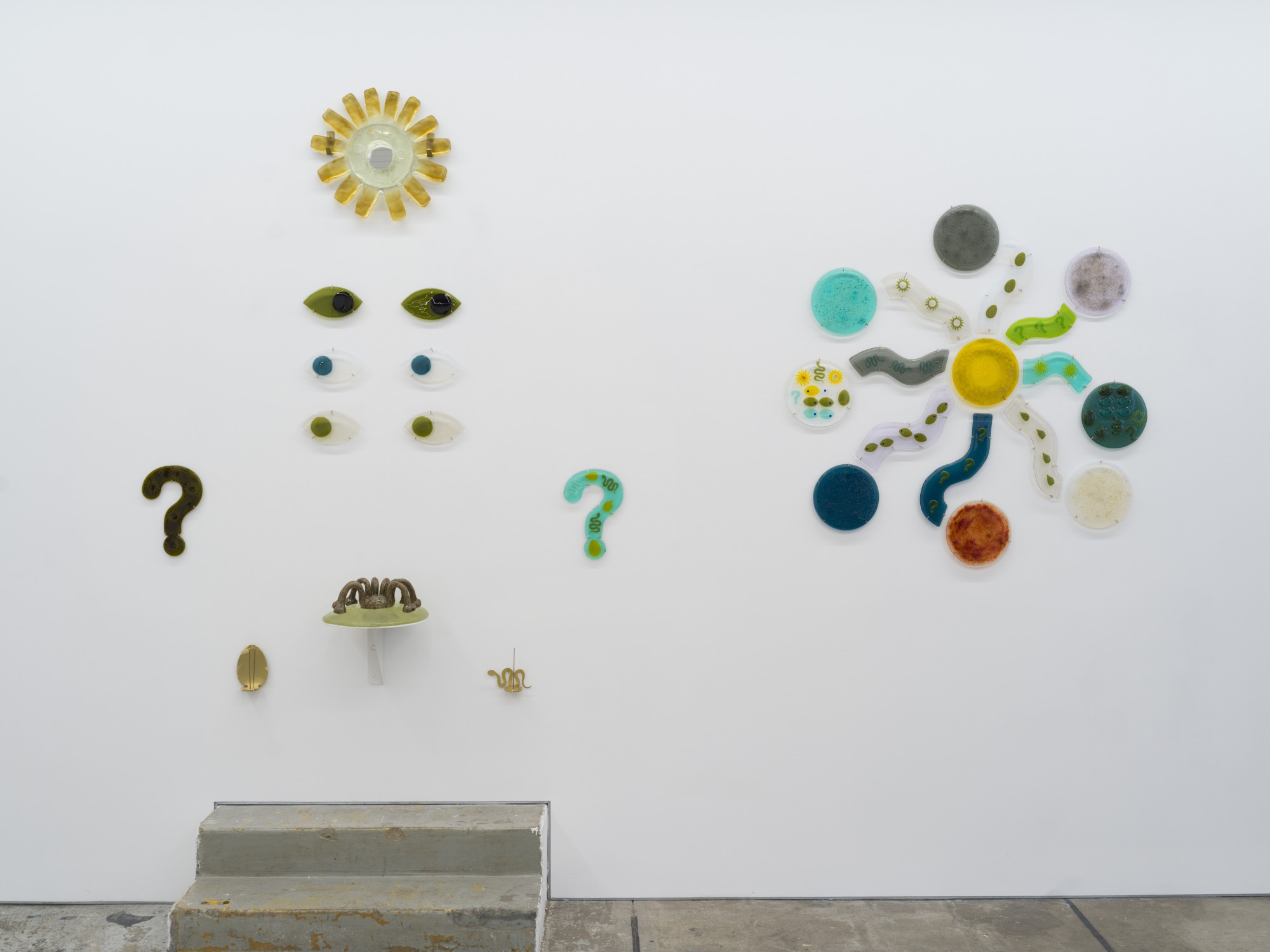
Interview: Tamara Henderson and Micky Schubert, Curator, Warrnambool Art Gallery
Micky: Your Warrnambool Art Gallery exhibition builds on your show at Camden Art Centre, where you introduced four characters: Director, Gardener, Light, and Sound. Here, you are focusing on Light. Could you elaborate on the significance of these characters and how Light in particular is developed in this iteration?
Tamara: Just as human identity forms through patterns of behaviour and response, materials too possess their own inherent behaviours and patterns. Glass responds predictably to heat and manipulation, light bends and refracts in consistent ways. These material behaviours become part of the character’s identity. The way they interact with space, light, and energy creates a unique entity that transcends its physical form.
In film and theatre, character sketching is a process of gathering traits mannerisms and qualities that will eventually be embodied by a performer, a practice rooted in witnessing and translation. My artistic practise adapts this methodology while diverging from traditional linear narratives and human performers. I work with materials, mediums, objects and energies which emerge from various seeds: lived experience, objects trouvé, dreams, research, references, observation. Once established they become archetype like vessels that can be expanded, filled, defined, pruned or weighted with meaning. A character might evolve into an entire room, mise en scéne, be of physicality or of energy, capable of shapeshifting across time and space, disappearing and re-emerging in new forms.
Green in the Grooves emerged through a process of distillation, gazing into the crystal ball of previous character bodies: Seasons End (50 characters), Womblife (5), and Canberran Characters (13). These entities were metaphorically placed in a compost bin of mind and body, alchemising into four essential forces: Light, Director, Gardner and Sound. This numerology reveals a language that speaks to cinematic structure. The Director maintains vision and projection, while Sound bridges both past and present connecting us to biophony and landscapes both accessible and hidden to the naked ear. The Gardener emerged as both subject and a talent, a muse exploring symbiosis, a disciple of the soil, moving at plant pace, casting a reverent gaze downward.
Light illuminates not only the scene but embodies vital energy for both human and planetary existence. A plant receives light from the sun, a star 149 million kilometres away, converting it into oxygen through a process of photosynthesis for biological life. Through this theory of similarity, the body can be understood as a reflection of the universe, where earthly rhythms are essential to both physical and psychic wellbeing. In Green in the Grooves, the principle of light emerged as a character concerned with the sun, moon and shadow — a transformative energy and source of visionary insight. The paintings emerged as extensions of body and mind, following trataka meditation where auxiliary function is suspended and focus is fixed on the flame of a candle for an extended duration.
The Spider with the Glass Legs installation deepens this established character. Like a cinematic tracking shot ascending tratakas glass body, uncoiling like a snake to a bloom of petals poised at the flame’s edge. As the camera continues to pan. This concentrated light of awareness penetrates the shadows of a former self, revealing an eight limbed entity, the Sunspider, jacked, groovy and grounded.
Sunspider merges two potent symbols: the sun, representing light, life, activation, and power, and the spider, evoking myths like Ovid’s tale of Arachne-symbolising transformation, fate and interconnectedness of web-spinning. How do you engage with these symbolic associations in your work? Do you see the Sunspider as a synthesis of oppositional forces, or does it represent something else entirely?
The Sunspider is an eight-limbed enlightened translator organising meaning and energy. While it echoes ancient mythological traditions, it maintains its own modern posture and status. Drawing from tantric wisdom, it alchemises oppositional forces, opening floodgates to weave webs of light into reality. Like its arachnid inspiration, whose web-weaving manifests as both functional architecture and natural artwork, this form embodies synergy through deconstruction and transformation, weaving together light and shadow, creation and destruction, in its search for balance.
At its core sits the Hermit who transforms into Wiseguide, a presence that gazes simultaneously into the future and past, entertaining emerald eggs, poisonous snakes and the sun. In Spider with the
Glass Legs, this entity manifests in variation of itself, a trinity of image, form and shadow, a multicoloured juggler of crystal spheres. As furniture, these spheres become grounding mechanisms, vessels of
illumination. The Sunspider’s presence extends through illuminated glass webs- wall sconces that capture and transform light while holding various totems within their strands: timepieces, flowers, shards, the Director. Like dreamcatchers, these woven glass works become repositories of symbols and meaning. The installation extends beyond visual realm through sound, propagating its original soundtrack from Womb Life (2018) as an acoustic atmospheric web throughout the space, while the sculptural form rests in its illuminated lair.
Weaving is a strong theme in your current show, but ultimately it also seems fundamental to your artistic practice, as you weave together different works, materials and experiences in time colliding the past with the presence and opening up possibilities for the future across multiple horizons. This is particularly evident in your use of sound. As you mentioned, the soundtrack was originally created for Womb Life in 2018, then reworked for the film in London, and now appears in Warrnambool in a newly modified version. On one level, the sound weaves together the entire exhibition, offering the audience a multi-sensory experience, on another it engages with a philosophical understanding of time as a primordial, embodied temporality, one that emerges through perception, where the past remains active in the present, and the future is always anticipated in every act of experience. Different temporal dimensions coexist and shape one another, creating a dynamic flow1. You also touched on this interplay of past, present, and future in the transformation of the Hermit into the Wiseguide. Could you explore this idea further?
Superposition in quantum mechanics suggests that a particle can exist in multiple states simultaneously until observed. Similarly, an artwork manifests energy harnessed from both collective and individual effort, existing in multiple potential states at once. The gallery becomes a primordial loom, weaving quantum threads of time, space and energy.
Like traditional weaving, where the warp provides the fundamental structure, my practice is anchored by a consistent methodology of character building and energy translation. This methodological warp creates a foundation through which various elements and mediums weave their way as the weft, creating a fabric of meaning.
In Spider with the Glass Legs, the Sunspider emanates as the central state of energy, its traits manifested through various expressions in the space. The soundscape composed by Johan Bjork and Charlie Knox translates the Sunspider’s internal rhythms into audible frequencies, evolving from natural ambience toward cosmic dimension. Just as the physical horizon suggests infinite space beyond what we can see, the internal sound of consciousness reveals a horizon of ‘beginninglessness’ and ‘endlessness’ like the primordial resonance heard in a seashell. This sonic dimension operates simultaneously on physical and metaphysical planes, connecting us to a vast web that has been weaving itself for millenia. The resulting composition is the Sunspider’s own vocalisation of these cosmic principles — a groovy, dynamic ecosystem of sound that invites listeners to experience its energetic pulse from the inside out.
The Wise Guide emerged from the Hermit, representing both a personal transformation and a universal archetype of inner healing. Situated at the Sunspider’s core (its solar plexus) the Wise Guide embodies essential qualities of balance, stability, growth and courage, anchoring the entity’s energetic anatomy in deep time, connecting present consciousness to ancient wisdom. Through automatic painting techniques, this figure materialised as a grounded presence, undulating from earthen browns to vital greens, crowned with illuminated yellow, a bridge between primordial depths and conscious awakening. This relationship between the Wise Guide and Sunspider embodies Tantric principles of transformation, where opposing energies merge into unity. Two gates in the installation further explore this duality, representing the Shadow aspects of both entities. Like the ancient practice of working with masculine and feminine energies, these elements, one earthbound and one cosmic, weave together to create a complete spiritual ecology.
You mentioned that you study different materials, their behaviours and patterns. Your practice involves an intricate dialogue between material intelligence, sensory perception, and symbolic transformation. In this exhibition, glass takes on multiple roles: as a vessel for light, a structural form, and a web of meaning. How do you see glass as an active agent in your work, and what draws you to its particular qualities of transparency, fragility, and transformation?
Glass exists as both primordial matter and human innovation — found in lunar soil samples and volcanic formation while also emerging from our earliest attempts at material alchemy. The basic recipe for glass has remained remarkably consistent since its first documentation on cuneiform tablets in the 17th century BC — sand transformed by heat, stabilised by minerals. Whether naturally occurring as obsidian or crafted in a furnace, glass embodies a unique state of matter, neither fully solid nor liquid. As a molecular level, its atoms maintain the random arrangement of a liquid while presenting as solid at room temperature, a paradox that speaks to its liminal nature. Today, this same material that touches nearly every facet of daily life continues to hold mysteries.
In a recent dream from early April, I found myself applying a mysterious substance to the surface of glass pieces in the studio, allowing them to oxidize — to breathe like living organisms. This intersection between the material and the metaphysical recalls André Breton’s principle of Communicating Vessels, where dream and waking life flow into each other like connected liquids seeking equilibrium. Breton describes dreams as ‘enabling capillary tissue’ between the exterior world of facts and the interior world of emotions — a permeable membrane between reality and imagination.
In 2017 this principle materialised when we collaborated with a master chemistry glassblower in Vancouver whose otherworldly presence and devotion to his craft equated to evoking a Philip K Dick Character, prompting us to title the work, ‘Galactic Glass Healer’. Like Dick’s Galactic Pot Healer who could recreate entire vessels from shards of their former selves, my practice continues to excavate and transform emergent entities, not through direct representation but through a surrealist methodology of allowing characters to arise from the intersection of dream and material reality. The Sunspider, like the Trataka flower before it, emerged not from studied arachnology but from this liminal space where glass itself exists appearing solid, yet perpetually in motion, ancient yet contemporary, found in lunar soil samples yet transformed daily in artists’ hands.
The relationship between artist and gaffer (a term of respect dating to the 16th century for the glassblower) embodies another form of communicating vessels, where vision flows into technical mastery. In the glory hole, where glass is reheated and transformed, ancient knowledge meets the innovations of the present. I witnessed this alchemy at Canberra Glassworks, the largest glass facility in the southern hemisphere, where the molten space becomes a magical portal of quantum synchronicity. Working with master glass artists like Netty, whose Libran sense of balance (born one day after me in 1982) seems cosmically aligned with glass’s nature, I watch in awe as she negotiates with material that exists between states. Like a mesmerising dance with gravity itself, the gaffer must keep the glass in constant rotation on the punty. This perpetual motion becomes a concentric ritual, maintaining the material’s form against the earth’s pull. Her nervous system, muscles, and breath in concert with the molten glass. Luna speaks of old windows that continue to move, of glass that is never truly static, like a liquid metal. Her eyes dance with the luminosity of a crystal shaman — the glass composition that she is a master in. She revealed how different glass compositions hold light, where soda lime glass captures light with sharp, candy like brilliance, crystal embraces it with a deeper more ethereal glow. These distinct qualities feel like different species of light bearing plants, each with their own character and resonance. The gaffer’s breath literally becomes part of the work trapped in bubbles that remain a testament to this profound human interaction with the material. As a filmmaker I’m captivated by glass’s time-based nature from its liquid state in the furnace, through its transformative dance with breath, movement and temperature, to its mysterious metamorphosis in the annealer, which acts like a photographer’s darkroom where the final form develops in darkness. This collaboration between artist and glass master creates its own form of alchemy, where visions meet ancient knowledge in an ongoing dance of becoming.
~
Originally published for the exhibition Spider with the glass legs by Tamara Henderson, presented by the Warrnambool Art Gallery from 24 May – 26 October 2025. © The authors, artists and Warrnambool Art Gallery, 2025.